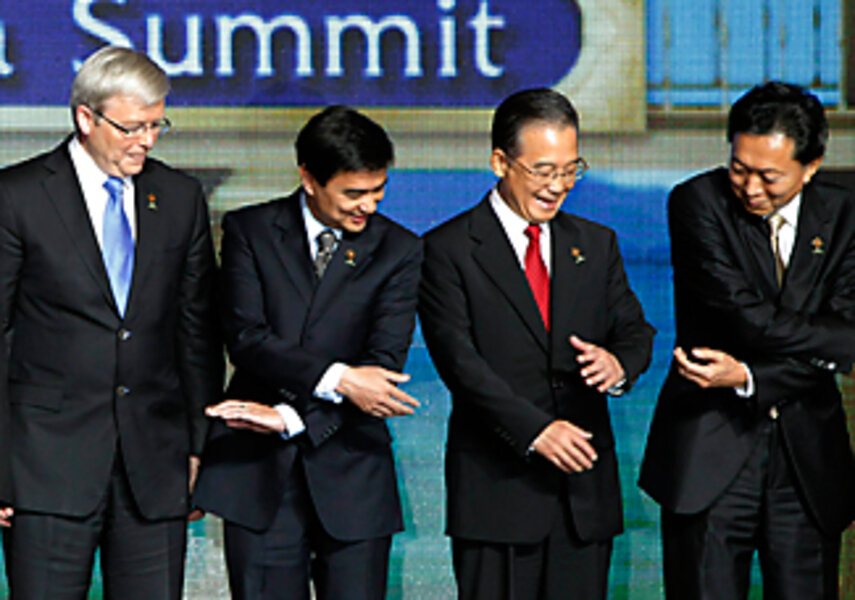Australia, Japan float rival plans for EU-style Asian bloc
Loading...
| Bangkok, Thailand
Regional partners to a Southeast Asian trade bloc have outlined rival proposals for a European-style economic community in Asia, home to the world's most dynamic economies.
At a weekend summit in southern Thailand, Japanese Prime Minister Yukio Hatoyama talked up the concept of an "East Asian community" with a common currency that would "lead the world." Australia's Prime Minister Kevin Rudd separately proposed an Asia/Pacific economic bloc that includes the US and cooperates on security issues.
But political obstacles to economic integration, such as questions over a US place in any economic grouping and rivalry between major Asian powers like China and Japan, may thwart a rapid rollout of either plan.
Tensions also exist over who would guide any transition to an open market for goods and services. The Association of Southeast Asia Nations (ASEAN), the regional grouping that hosted the 16-nation summit, fears being upstaged by larger economies and reduced to a junior role.
In theory, ASEAN is supposed to establish a common market of over 500 million people in ten member-countries by 2015. But that deadline is widely seen as overly ambitious given the political and economic disparities between members, as well as niggling bilateral rifts on display at the summit.
Stronger Japanese diplomacy?
Mr. Hatoyama recently took office promising to put a stronger spin on Japanese diplomacy in Asia. His proposal for East Asian economic unity appears to be the first fruit, says Michael Montesano, a visiting fellow at the Institute of Southeast Asian Studies in Singapore.
"It's a reminder to ASEAN that the pace of ASEAN-centered integration has been slow. ... The real issue is whether [Japan's proposal] is controlled and managed by ASEAN or not. That's a real source of anxiety," he says.
Mr. Rudd's plan for a broader economic alliance is even less palatable as it may eventually impose political standards on members, says Mr. Montesano. By contrast, ASEAN watered down commitments to human rights and democracy in its charter adopted this year in deference to members like military-ruled Burma and communist Vietnam.
One plus for Mr. Hatayama's proposal is that it builds on ASEAN's existing ties to China, South Korean, and Japan. That fits Beijing's vision, says Thitinan Pongsudhirak, director of the Institute of Security and International Studies at Chulalongkorn University in Bangkok.
"China has always preferred a tighter, more organized East Asian framework," he says.
What role for the US?
But Japan may want to bring in the US as a counter-balance to China's growing power in Asia, he adds, potentially stirring up rivalry in Northeast Asia.
Australia's proposed grouping extends across the Pacific and appears similar in scope to the Asia Pacific Economic Cooperation forum that holds its annual meeting next month in Singapore. The Australian plan includes India, which signed a limited trade pact with ASEAN in August.
However, domestic resistance to existing trade agreements in Asia point to the difficulty of integrating economies, particularly when sensitive sectors like agriculture are thrown into the mix.
In Thailand, a 2003 bilateral trade accord with China has sowed anger among small farmers who complain of a flood of cheap Chinese products. Other regional trade pacts have floundered for the opposite reason, as protectionism keeps out competitors by means of non-tariff barriers. Thailand and the Philippines clashed recently over rice import quotas within ASEAN.
Over the past decade, trade flows within ASEAN have steadily increased. But most of the gains are between more open economies like those of Malaysia and Thailand, not laggards like Burma and Cambodia. This has created a two-tier system that may be hard to integrate, unless smaller players opt out. Moreover, the region still relies on exports to Europe, the US, and Japan, though China is increasingly a destination for semi-finished products and commodities.
ASEAN's internal squabbles
ASEAN, which began in the 1960s as an anti-communist alliance, is also beset by internal squabbles. In recent days, Cambodia and Thailand have sparred openly over the status of former Prime Minister Thaksin Shinawatra, who is living in exile and is a fugitive from Thai justice.
At the summit, Cambodia's Prime Minister Hun Sen told reporters that Mr. Thaksin was welcome in Cambodia, even as Thai diplomats insisted that he should face arrest and extradition if he traveled there. Over the past year, the two countries have fought armed skirmishes over a disputed border temple, an issue that ASEAN has been powerless to tackle.
By siding with Mr. Thaksin and snubbing the current government, Hun Sen has dived headlong into Thailand's fraught politics, says Mr. Thitinan. "Everyone knows that Thailand is deeply divided and polarized and the way to deal with it is to stay out of it," he says.





